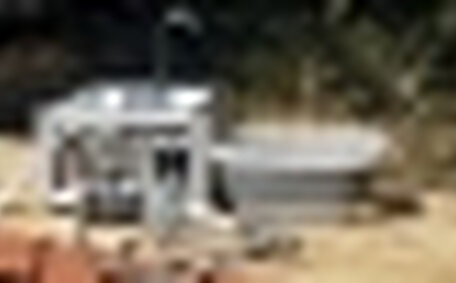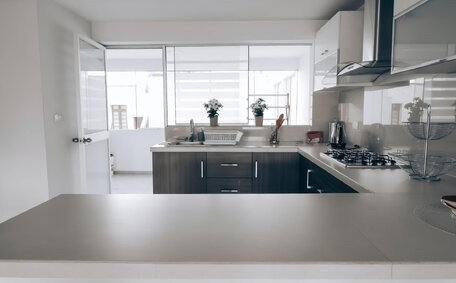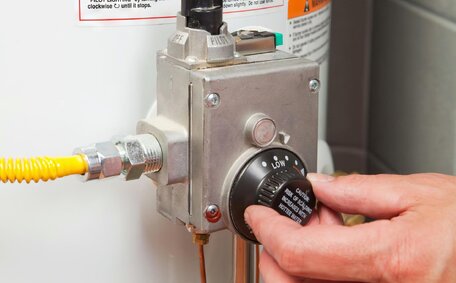Learn the ideal hot water system installation practices with insights from Riverwood Plumbing, your trusted experts in top-tier brands.
Selecting the ideal location for your hot water unit is crucial for maximising energy efficiency, adhering to safety standards and ensuring easy access to hot water. Placement directly influences system performance.
Riverwood Plumbing’s professional team specialises in optimal hot water unit placement throughout the Northern Beaches and Sydney, providing personalised advice for various systems, including heat pumps, solar, and gas.
We evaluate factors like pipe layout, usage points, noise levels, and maintenance access to determine the best position for your hot water system.
This guide offers key tips for the suitable placement of your hot water system within residential and commercial settings, ensuring convenience, cost-effectiveness, and safety.
Key Factors In Determining Hot Water System Location
Key factors must be considered when installing a hot water system or replacing an existing one to determine the optimal location:
Proximity to Fixtures and Usage Points
To achieve peak efficiency, position the hot water system close to fixtures requiring immediate hot water access.
Such positioning reduces heat loss across long pipes. Typically, kitchens and bathrooms are high-demand areas for hot water, followed by laundries and garages.
System Type
The type of hot water system, such as tankless water heaters that provide a continuous flow of hot water, shapes its ideal location. Gas and electric storage systems require indoor installation for proper ventilation, while heat pumps and gas units are often positioned outdoors. Accessibility for maintenance should also influence the placement decision.
Space and Clearances
Adhering to the manufacturer’s guidelines for ventilation and service access is critical to ensuring safety. Indoor units need sufficient floor space and, where necessary, raised platforms.
Outdoor units, especially solar water systems, must have clear access to sunlight to operate efficiently and comply with regulatory standards.
Noise and Disruption
Heat pumps and solar collectors can be noisy; it’s considerate to notify neighbours if units are installed on shared walls.
It’s advisable to steer clear of situating noisy equipment close to bedrooms or common living spaces.
By considering these factors, our team expertly identifies the optimal location for the most efficient operation of your hot water heater.
Proximity To Fixtures
Placing the hot water system close to high-demand fixtures such as kitchens and bathrooms boosts efficiency by reducing heat loss. Experts advise keeping the piping between the water heater and the furthest hot tap under 10 metres.
Locating the system near key usage points helps maintain a consistent hot water supply and diminishes the volume of cooled water in the pipes.
This approach conserves energy due to reduced reheating needs, possibly qualifying you for hot water rebates, as less energy is needed to bring cooled water back to the desired temperature at each tap. In an average household, situating the hot water storage system near central wet areas can slash heat loss by at least 25%.
Accessibility For Maintenance
Selecting a location that provides easy access for servicing and repairs is essential when choosing where to place new hot water systems. This ensures your old unit can be easily maintained over its lifespan, which can support optimal performance and longevity.
Indoor units like the hot water tank should be positioned so the service panels can be reached without obstruction. Provide adequate clearances around the full circumference for maintenance access as per the manufacturer’s recommendations. Also consider ease of access to internal components like heating elements or anodes.
Outdoor installations like pump hot water system units or solar collectors should have unblocked access pathways to enable check-ups, cleaning and repairs on electric water units. Roof-mounted solar units will require safe access up to the roof area. Make sure outdoor units are reachable with ladders or scaffolding.
The location should also allow adequate room for replacing parts or even an old hot water heater down the track. Select an area that won’t require major renovations to swap out the old unit for a new one when needed.
At the same time, aim for placements that don’t negatively impact the home or building’s aesthetics. Conceal outdoor units behind screens or landscaping if possible. The goal is functionality without compromising visual appeal.
Also consider ease of access to internal compg.
Ventilation Requirements
Proper ventilation is paramount for the safe and efficient operation of indoor gas or electric hot water systems, as they emit exhaust gases and heat. In compliance with Australian Standard AS/NZS 5601.1, openings, vents, or grilles must facilitate the flow of fresh air into the systems.
Consider installing the unit in a utility room or garage with louvred doors to maximise air circulation.
Bathroom installations require extraction fans rated over 15L/s. Avoid small enclosed spaces lacking airflow. Correct ventilation is vital for safe and efficient operation.
Outdoor units, which we supply and install, demand less rigorous ventilation but still need enough clearance for air intake around the condenser coils. Our technicians can evaluate and cater to your needs ensuring compliance to all relevant standards during installation, optimally heating water for your hot water delivery.
Noise Considerations
Choosing the best location for installing a hot water system involves considering potential noise, particularly from heat pump and solar collector systems that use pumps. These units can generate noise comparable to an air conditioning system or a refrigerator.
To minimise noise issues, avoid placing outdoor heat pump or solar hot water systems adjacent to bedrooms or living spaces. Wall installations should not abut neighbours if possible to limit shared noise transfer. Additionally, inform nearby residents beforehand if the unit will be installed in a shared location.
For indoor tankless or storage systems, place the heat pump hot water heater inside, away from the recreation or relaxation areas of the home or building. Sound dampening materials like insulation can help reduce vibrations and operation noise emanating through walls and ceilings if necessary.
Overall, strategic placement is key for managing noise from pumps, fans or other internal components. Our experienced installers can advise quiet locations that promote peaceful enjoyment without disruption and get the job done effectively. Correct installation not only optimizes performance but also ensures comfort.
Safety And Compliance With Standards
Adherence to all pertinent safety regulations and standards is essential during the installation of hot water systems, guaranteeing both occupant safety and compliance with Australian regulations.
Installations of gas water systems must comply with AS/NZS 5601.1:2013, specifying details on combustion, ventilation, necessary clearances, controls, and more. Furthermore, rigorous gas connection and leak testing protocols are essential.
Regulatory requirements dictate the installation of tempering valves on hot water systems to prevent scalding in areas serving bathrooms, kitchens, and similar sites. Tempering valves automatically blend hot water with cold water to provide a consistent temperature around 50°C.
Riverwood Plumbing’s certified technicians strictly comply with Australian standards for all hot water system types, staying abreast of the latest regulations to ensure your system’s safety and performance.
Indoor vs. Outdoor Installation
There are advantages and potential drawbacks to both options that must be weighed for your specific situation.
Indoor installations, particularly for gas water heaters or electric storage tanks, offer protection from the elements and mitigate weather damage risks. They are also easier to access for maintenance and servicing without ladders or roof access needed. However, they take up interior floor space and require ventilation measures.
Outdoor units such as heat pump hot water systems or solar collectors maximise efficiency since your hot water system can benefit from unlimited airflow and don’t occupy living space. But they can be exposed to heavy rain, wind, or hail storms which may shorten their lifespan. Accessing roof-mounted systems safely is essential for service.
The pleasant Sydney weather conditions often make outdoor installation a suitable choice for various type hot water setups. But very hot or cold temperatures can reduce system performance and efficiency for heat pumps or solar models. An indoor utility room may be better insulated and temperature controlled.
For Riverwood and surrounding areas, we carefully assess whether indoor or outdoor installations best suit solar water heaters, offering recommendations tailored to your specific hot water system type and home layout. This ensures the best reliability, lifespan and performance.
Specific Considerations For System Types
The optimal placement location can vary based on the type of hot water system being installed. Here are some of the key considerations for different system types:
Solar Hot Water
Solar collectors need full exposure to the sun’s rays, typically on a h adequate ventilation and clearances. Raised stands may be needed in flood zones.
Place solar hot water units close to gas and electricity connections for optimal installation efficiency.
Electric Storage
Electric storage units can be installed indoors or outdoors, ensuring that condenser coils maintain unrestricted airflow.
Solar collectors need full exposure to the sun’s rays, typically on a north-facing roof. Insulated pipe runs from the roof to usage points should be minimised.
Objectives nearby that create shade should be avoided to ensure solar collectors receive unimpeded sunlight.
Gas Storage
Optimizing Efficiency And Longevity
Proper placement of your new hot water system is crucial for maximising its energy efficiency and longevity. Here are some tips from the experts at Riverwood Plumbing for getting the most out of your investment:
- Place gas or electric storage tanks indoors to protect them from weather and position them nearest to high-demand hot water taps, which extends their service life. Ensure adequate ventilation when you install a hot water system.
- Situate units centrally, especially near bathrooms and kitchens where hot water is most needed to curtail lengthy pipe runs and heat loss. Each 3 metres of piping can cause up to 10% in energy waste.
- Insulate hot water lines with foam lagging to prevent heat dissipation and more effectively heat water. Use the shortest pipe path possible.
- Install solar collectors on unshaded north-facing roofs where users want closest hot water access with optimal solar absorption. Minimise distance to usage points.
- Allow sufficient clearances and access for maintenance. Cramming units into tight spaces makes repairs difficult.
- Mif distance to taps exceeds 10 metres to keep hot water on hand.
Strategic placement of your hot water system near high-use taps saves energy and prolongs its lifespan. Riverwood Plumbing champions smart hot water positioning.
For solar hot water systems, optimally placing the solar collectors is key for peak efficiency. Site them to avoid shading and to capture the most solar energy. Position the collectors as close as possible to the indoor storage tank to minimise heat losses in the pipework. Allow for safe access to the roof area for maintenance. Correct orientation and minimal shading are key for solar hot water efficiency.
The collectors should be situated on an unshaded, north-facing roof at an angle of 30 to 50 degrees for ideal exposure to the sun’s energy in Sydney’s latitude.
Heat Pump Placement To Maximize Performance
Properly placing pump hot water heaters is crucial for ensuring optimal efficiency and performance, often requiring blended plumbing electrical expertise. Heat pumps operate most effectively in temperatures above 7C, so avoid unheated spaces like garages. Install outdoor units in full sun and provide at least 450mm clearance on all sides for airflow across condenser coils. Heat pumps operate most effectively in temperatures above 7C, so avoid unheated spaces like garages. Following these best practises for strategic placement enhances heat pump water heater efficiency, longevity and convenience.
Place units away from windows to reduce noise, mounting them securely on a concrete base to prevent vibration and ensure indoor units have proper ventilation, such as in utility rooms with louvred doors.
Regular Maintenance
Regular servicing by a licensed plumber every 3-5 years is central to maintaining operational safety and efficiency for gas, electric, solar, and heat pump systems, including the water tank.
Maintenance involves checking all components for corrosion, adjusting gas burners and pilot lights as necessary, and replacing the anode rod in hot water tanks when depleted. Cleaning coils and air filters of debris is also essential for pressure relief and efficiency. Such preventative measures help avoid costly issues and maintain lower energy bills.
Conclusion
Identifying the location for the system your residence requires, nearest to the closest hot water unit for installation, is vital for optimal convenience, efficiency, durability, and regulatory adherence. Carefully weighing all the factors covered in this guide will help property owners in Riverwood and across Sydney make the right choice for your system in their unique home or business setup.
Key considerations include proximity to high usage points like bathrooms and kitchens, accessibility for future maintenance, ventilation needs, noise mitigation strategies, adherence to safety standards, and system-specific requirements. An indoor versus outdoor placement also merits careful comparison of benefits and potential drawbacks.
While detailed, selecting a hot water system’s installation spot should not be complex. Our consultative approach guides you toward locations that enhance performance, convenience, and regulatory conformity.
Our experienced, licensed plumbers at Riverwood Plumbing provide professional, personalised guidance for your hot water requirements, ensuring your complete satisfaction.
Depend on our skilled team for precise placement of hot water systems, whether installing anew or replacing an old unit. Correct positioning helps eliminate energy waste, cut operating costs, and guarantee consistent hot water availability.
Contact us today to book an appointment or receive a quote; installations could be arranged as soon as tomorrow.






